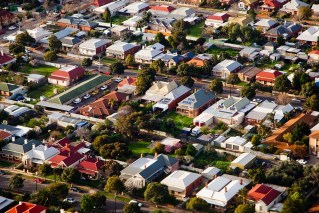‘Coldest I have ever been’: Australia’s cold houses create a TikTok shock

Source: TikTok/Canadians in Tassie
Plunging winter temperatures across the country have Australians, and some unlucky visitors, taking to social media to ask an important question: Why are our houses so cold?
Cities and regions across the country, especially the south-east, are enduring some of their coldest temperatures of the year, prompting an unfortunate social media trend.
Questions are even coming from people from countries we might normally think of as much colder than Australia.
One Canadian living in Australia said people often told her that she would be fine during our winter.
“But I can confidently tell you that the coldest I have ever been is living in a Melbourne share house in the middle of July, in my own bed, trying to fall asleep, being able to see my own breath,” TikToker Alexandra Tuohey said.
Source: TikTok/Alexandra Tuohey
Back in May, another Canadian said Australia had “ruined” him, when it was just 18 degrees.
“I’m from Toronto – 16 degrees Celsius when I lived in Toronto was like, you would wear T-shirts and shorts and be like celebrating life,” he said.
“And not [in Australia], I can barely operate and I am wearing a f—ing North Face jacket. Who am I turning into?”
In April, before winter even took hold, one Norwegian said Australian winters had “humbled” her.
“It’s April and I’m already like, I can’t feel my fingers, it’s so f—ing cold,” she said on TikTok.
“Everyone’s like ‘you’re from Norway, like you should be fine with Australian winters’. No, Australian winters are the worst.”
Of course, it’s not just the expats rugging up. Australians have long grappled with this issue.
Why are Australian homes so cold?
There’s a simple reason as to why Australian homes are freezing in the winter: The lack of insulation.
Many Australian homes are better built to deal with the warmer conditions we enjoy in summer.
RMIT senior lecturer Nicola Willand said most Australian homes were poorly insulated and had inefficient heaters that could be expensive to run.
“If you don’t have [proper insulation], heat just dissipates out, so even though you may be heating [the room], you don’t really feel the room warming up,” Willand said
The World Health Organisation has an internationally recognised benchmark for defining cold in homes – its Housing and Health guideline, which puts a minimum indoor temperature at 18 degrees.
A study published in 2023 found that 81 per cent of Australians homes sampled between June and August in 2022 were colder than that.
“These early findings suggest that the problem of unhealthily cold homes in Australia is likely to be significantly more prevalent than previously estimated,” the study said.
“Far from affecting 5 per cent of Australian households, the affected population may be 10 times this value.”
Not only is it uncomfortable being in a cold home, but it can affect health with respiratory and cardiovascular diseases spreading more easily in cold conditions, as does mould.
Willand said the cold could also affect mental health and lifestyles, because once the temperature drops people often don’t want to invite visitors over because it’s too cold.
“Children don’t want to sit in their own bedrooms, where it would be quiet to do the homework,” she said.
“They come into the kitchen, which is often the warmest room … and then they can’t concentrate.”
What can people do?
Many of the expats shocked by Australia’s frosty weather have seemingly bought themselves jackets to keep warm.
Layering up is always an option, but there are other ways to keep homes warmer in winter, without turning on the heaters.
It’s worth draught-proofing the home, by plugging the gaps between doors, windows and walls, to make sure it is better insulated.
“If you see little gaps around the windows – you can see the sky – that means there are holes where the warmth just flows out very quickly,” Willand said.
Hardware shops will stock items needed to draught-proof homes, including tape or panelling, and it’s a job that can be done without experience.
Ceiling insulation also helps prevent heat from rising.
Heavy curtains, particularly ones that reach the ceiling, will also stop heat from exiting through windows.








